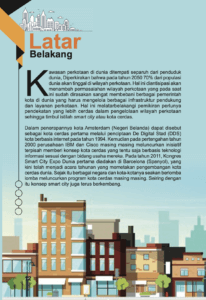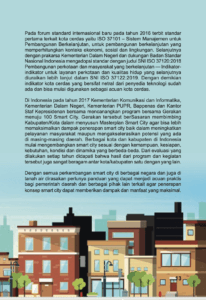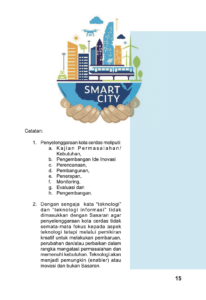Background
Urban areas in the world are home to half of the world’s population. It is estimated that by 2050 70% of the world’s population will live in urban areas. It is anticipated that this will add to the problems of urban areas which are currently felt to be very burdensome for various city governments in the world who have to manage various supporting infrastructure and urban services. This is the background to the need for a smarter approach in managing urban areas, which is why the term emerged smart city or smart city.
In its application, the city of Amsterdam (Netherlands) can be called the first smart city through the creation of De Digital Stad (DDS), an internet-based city in 1994. Then in mid-2000 the companies IBM and Cisco each launched separate initiatives to provide a smart city concept which was of course based on information technology according to their business fields. In 2011, the first Smart City Expo World Congress was held in Barcelona (Spain), which has now become an annual event mapping the development of world smart cities. Since then, various countries and cities have been competing to launch their own smart city programs. Along with this, the smart city concept also continues to develop.
At the new international standards forum in 2016, the first standard related to smart cities was published, namely ISO 37101 – Management Systems for Sustainable Development, for sustainable development that takes into account the economic, social and environmental context. Furthermore, with the initiative of the Ministry of Home Affairs and the support of the Indonesian National Standards Agency, it adopted a standard with the title SNI ISO 37120:2018 Sustainable urban and community development — Indicators for urban services and quality of life which are further described in SNI ISO 37122:2019. Thus, neutral smart city indicators from technology providers already exist and can be used as a reference for smart cities.
In Indonesia in 2017 the Ministry of Communication and Information, Ministry of Home Affairs, Ministry of PUPR, Bappenas and the Presidential Staff Office jointly launched a joint program Movement towards 100 Smart Cities. This movement aims to guide districts/cities in preparing Smart City Masterplans so that they can further maximize the impact of implementing smart cities, both in improving community services and accelerating the potential that exists in each region. Various cities and districts in Indonesia are starting to develop smart cities according to their different capabilities, readiness, needs, conditions and dynamics. From evaluations carried out every year, it is found that the results of these programs and activities also vary greatly from one city/district to another.
With all the developments in smart cities in various countries and also in Indonesia, it is felt that there is a need for a guide that can be a practical reference for local governments and various other related parties so that the application of the smart city concept can provide maximum impact and benefits.
Definition of Smart City
The definition of a smart city depends a lot on the point of view and interests of the party formulating it, as well as because smart cities are a broad and complex subject seen from various aspects. As one example ITU (International Telecommunication Union) which defines it as “an innovative city that uses information and
communication technologies (ICTs) and other means to improve quality of life, efficiency of urban operations and services, and competitiveness, while ensuring that it meets the needs of present and future generations with respect to economic, social and environmental aspects”. Which more or less means “a city that utilizes information and communication technology and other things to improve the quality of life, efficiency of urban operations and services and competitiveness for current and future needs, taking into account
economic, social and environmental aspects”.
Simplifying the definition of a smart city for Indonesian conditions, it can be called “an urban area organized through sustainable innovation with attention to balance
between economic, social and environmental aspects”.
Notes:
- Smart city management includes:
- Problem/Needs Study,
- Development of Innovation Ideas
- Planning,
- Development,
- Application,
- Monitoring,
- Evaluation and
- Development.
Deliberately the words “technology” and “information technology” were not included with the aim that the implementation of smart cities does not solely focus on technological aspects but through creative thinking to carry out updates, changes and/or improvements in order to overcome problems and meet needs. Technology will be an enabler or innovation and not a target.
Published by :
Ministry of Home Affairs of the Republic of Indonesia Directorate General of Regional Administration Development







